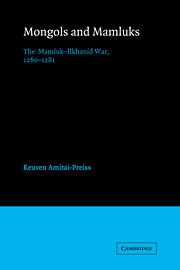Book contents
- Frontmatter
- Contents
- List of illustrations
- Preface
- List of abbreviations
- Notes on dates and transliteration
- Introduction
- 1 The historical background
- 2 The battle of ʿAyn Jālūt
- 3 The formulation of anti-Īlkhānid policy
- 4 The search for a second front
- 5 Military and diplomatic skirmishing
- 6 The secret war
- 7 Baybars's intervention in Seljuq Rūm
- 8 Baybars's posthumous victory: the second battle of Homs (680/1281)
- 9 The Mamluk–Īlkhānid frontier
- 10 Mamluks and Mongols: an overview
- Maps
- Genealogical Tables
- Glossary
- Bibliography
- Index
2 - The battle of ʿAyn Jālūt
Published online by Cambridge University Press: 23 November 2009
- Frontmatter
- Contents
- List of illustrations
- Preface
- List of abbreviations
- Notes on dates and transliteration
- Introduction
- 1 The historical background
- 2 The battle of ʿAyn Jālūt
- 3 The formulation of anti-Īlkhānid policy
- 4 The search for a second front
- 5 Military and diplomatic skirmishing
- 6 The secret war
- 7 Baybars's intervention in Seljuq Rūm
- 8 Baybars's posthumous victory: the second battle of Homs (680/1281)
- 9 The Mamluk–Īlkhānid frontier
- 10 Mamluks and Mongols: an overview
- Maps
- Genealogical Tables
- Glossary
- Bibliography
- Index
Summary
Then when Ḳôtâz the Turk, who reigned in Egypt, heard that the King of Kings [Hülegü] had gone away … and that Kît Bôghâ alone with ten thousand men remained in Palestine, he collected the armies of Egypt and sallied forth and met the Tatars in battle in the plain of Baishân …
Bar HebraeusThe Mongol invasion of Syria
At the beginning of AH 658 (the year commencing on 18 December 1259), Mongol troops under Hülegü, accompanied by Georgian, Armenian and Rūmī Seljuq contingents, crossed the Euphrates and took up position outside Aleppo. Already at the end of the previous hijrī year a Mongol force had penetrated Syria, raided as far as Aleppo, inflicting a severe beating on a local force before withdrawing. This time, however, the Mongols had more than a transitory raid in mind. Al-Nāṣir Yūsuf's governor, the venerable al-Malik al-Muʿaẓẓam Tūrānshāh (a son of Saladin), was called upon to surrender. His refusal led to the investment of the city on 2 Ṣafar/18 January. It was taken a week later, and was subjected to the usual slaughter and looting. The defenders of the citadel continued to resist and it took another month before it capitulated. Surprisingly enough, Hülegü let the defenders live, although the citadel itself was subsequently destroyed. Thereupon Hülegü marched west-ward and obtained the surrender of Ḥārim, which was still sacked for temporizing, and then apparently returned to the neighborhood of Aleppo, where he received delegations of notables from Hama and Homs who tendered the submission of their cities.
- Type
- Chapter
- Information
- Mongols and MamluksThe Mamluk-Ilkhanid War, 1260–1281, pp. 26 - 48Publisher: Cambridge University PressPrint publication year: 1995
- 1
- Cited by

